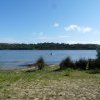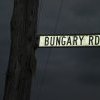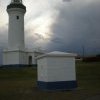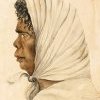1800s
1800
The time has passed when the raids on the ripening cornfields are merely an alternative form of food gathering. The object of the recurrent, well planned attacks is to drive the white men off the river. New settlers taking up virgin land are attacked indiscriminately with those who had been marked down for vengeance. Four years of intermittent guerilla fighting gradually reduces the tribes along the lower Hawkesbury by 1803. (Docker 1964, p. 70)
1800 - 1803
Birth of Biddy (Sarah Wallace) in Broken Bay. Her father is named on her death certificate as ‘Richard Wallace, Aboriginal’). Some of her descendants today think that her father may have been a British seaman, Richard Wallace. Her mother is ‘Queen’ Matora, a wife of Bungaree.
Biddy is known as Sarah Wallace, belongs to the Broken Bay clan of Bungaree, and is sister to Bowen and Toby.
1801
Garigal clan leader Grewin from Patonga leads his clan in Pittwater helping seamen and plundering wreckage from shipwrecks. Report by Lieutenant James Grant who walks from North Head to Pittwater accompanied by three Garigal men, four women and two children. They meet 10 other Garigal people camped at “Narrobine [Narrabeen] Lagoon”.
1802 - 1803
Bungaree sets out on 22 July on the Investigator to circumnavigate Australia with Matthew Flinders and another Koorie man Nanbaree, who has been brought up in the settlement by Surgeon White. Bungaree is the first Indigenous man to circumnavigate Australia. Nanbaree returns to Sydney earlier as he is homesick.
Bungaree communicates with Islanders in the Torres Strait and the expedition also encounters Pobosso, a Macassan fleet captain with a fleet of prahu (small sailing) ships from Sulawesi in Indonesia. Bungaree often acts as Flinders’ heroic ambassador as he strips naked to swim ashore to greet Aboriginal people. As the condition of the ship and crew deteriorated Flinders makes for Coupang in Timor where they stay for a week. The Investigator returns to Sydney via the west coast. (Smith 1992)
On his return, Bungaree brings the Broken Bay clan to settle in Port Jackson. He makes camp at Kirribilli.
1803
1804
An increase in number of conflicts when the “maize was ripe”. Farming has largely prevented access to the river for food gathering for the Aboriginal people. Many are starving. The Koori view of life is that food is there to be gathered, in one’s own country, and the ripe corn has replaced the wild daisy yams that have grown on the river banks. Many farmers use Aboriginal labour to help them gather crops but fail to pay them adequately for their work. If Koori people cross farmers’ land they are liable to be shot at. Governor King hears testimony from three Koori men that if they can retain certain places on the lower Hawkesbury, they will be satisfied and not in trouble the farmers. King rashly assures them that no more settlements will be made lower down the Hawkesbury – north-coastal country. (Historical Records of New South Wales, vol 5, p. 513)
Reports on 24 June 1804 of 150 Aborigines who strip farms of crops, poultry, clothes and goods; spears are thrown at a settler who opposes them. (Sydney Gazette, 24 June 1804)
An old Koori man is Grewin living on Dangar Island in the Hawkesbury (Mullet Island). Some ex-convicts salt boiling on the island, are attacked and their clothing taken by Koories. Two other friendly Koories escort the men back to Sydney unharmed. (Swancott 1967, p. 14)
James Webb’s boat again attacked by Aboriginal warriors led by Woglomigh. Woglomigh is known to the colonists as “notorious”.
Newspaper Sydney Gazette reports Aboriginal people on a beach saving crew from the sinking ship Speedwell near Lion Island. “The very humane, friendly and precautionary conduct of an ancient native … would reflect the highest credit to a polished member of civilized society”. (Sydney Gazette)
Governor King sends Bungaree on the ship Resource to help with negotiations with Awabakal people at Hunter River near Newcastle where the penal settlement has been reopened. Bungaree also is asked by King to escort six Koories from Hunter River back home. Bungaree stays on to assist Lieutenant Menzies, in charge of the Kings Town (Newcastle). Returning by foot to Sydney, runaway convicts attack Bungaree’s clansmen as they pass through the Central Coast area and kill Bungaree’s father. Bungaree becomes an Elder of his clan.
Bungaree visits his family’s settlement in Sydney more frequently for tribal gatherings and becomes a favourite of Governor Macquarie. The Governor wants Aboriginal people to settle down to grow crops and other sedentary activities. (Historical Monograph, Brisbane Water Historical Society, 1981)
1805
Renewal of hostilities between Aborigines and settlers on the Hawkesbury.
Governor Macquarie gives a government General Order that
The natives in different parts of the out-settlements have in an unprovoked … manner lately committed the most brutal murder on some defenseless settlers … the government has judged it necessary for the preservation of the lives and properties … to distribute detachments from the NSW Corps. (ie soldiers) (Karskens 2009, ch 13)
Aboriginal people try to defend their land and kill colonists. On 20 July, Judge Advocate Richard Atkins rules that Aboriginal people “are at present incapable of being brought before a criminal court, and that the only mode at present when they deserve it, is to pursue them and inflict such punishment as they merit”. (Foley 2001)
Musquito, an Aboriginal Guringai warrior is arrested for attacks on farms on the Hawkesbury River. He is imprisoned and sent to Norfolk Island and later to Tasmania in 1813. Musquito’s first hand knowledge of bushranging tactics is used by authorities to help round up outlaws in Tasmania. He becomes a leader of resistance and organises large scale guerilla attacks against colonists. He is sentenced to death for murder in 1825 in Hobart gaol. His final words are said to have been I“This not good for black fulla. Only good for white fulla [speaking about being hanged]. Him buddy (bloody) used to it by now.”











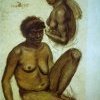
 drawn by Mikhailov, 1820, courtesy AIATSIS.thumbnail.jpg)

